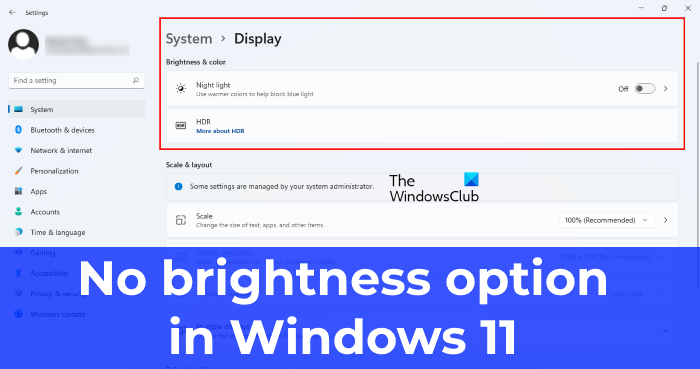The issue also occurs if the Generic PnP Monitor is disabled. You can check this in the Device Manager. Open Device Manager and expand the Monitors node. Right-click on the Generic PnP Monitor and see whether there is an option to enable the driver. If yes, enable it. Now check if the brightness slider is available in the Settings app or not. If this does not fix the issue or if the PnP Monitor is not disabled on your computer, try the below solutions.
No Brightness slider in Windows 11
Is the Brightness slider or control missing in Windows 11? If the Brightness control is not working or there is no Brightness in Settings, then try the following fixes and see if they bring the Brightness slider back in Windows 11 Settings: Let’s see how to check these settings.
1] Check the Group Policy Settings
The brightness option disappears from Windows 11 Settings if a setting named Disable the Display Control Panel is enabled in Group Policy Editor. You can check this setting in Gpedit on your computer. Disable this setting if you find it enabled. Do note that Group Policy Editor is not available on Windows 11 Home edition. Therefore, Windows 11 Home users can skip this method. The following steps will help you how to disable this setting: Now, let’s see these steps in detail. 1] Launch the Run command box and type gpedit.msc. Click OK. 2] In the Group Policy Editor, navigate to the following path:
3] On the right side, you will find a setting named Disable the Display Control Panel. Because the brightness slider is missing in the Settings of your computer, you may find this Group Policy setting enabled. You have to disable it. 4] Double-click on this setting and select Disabled. Click Apply and then OK.
5] Now, restart your computer. This should bring the brightness slider back in Windows 11 Settings. If it does not work, select Not Configured in step 4 above and restart your computer again. See if it brings any changes.
2] Check the Registry Value
There is a Value in Registry that hides the brightness slider in Windows 11 Settings app and makes it grey in the Quick Settings. Hence, changing this Value may fix this issue. Before you proceed, we recommend you create a system restore point or backup of the registry. Let’s have a look at these steps in detail. 1] Launch the Run command box by pressing Win + R keys. Type regedit and click OK. If you receive a UAC prompt, click Yes. 2] Navigate to the following path. You can copy the path and paste it into the address bar of the Registry Editor, and press Enter.
3] Expand the Policies key and select the System subkey. Because the brightness slider has disappeared from the Settings of your computer, the Registry Editor should show a Value named NoDispCPL on the right pane. Double-click on this Value and change its Value Data from 1 to 0. 4] Click OK. 5] Close the Registry Editor and restart your computer. If there is no System subkey under the Policies key, you can try creating a new one and see if it helps. For this, right-click on the Policies key and go to “New > Key” and name the newly created key as System. Now, select the System key and take your cursor on the right pane. Right-click in the empty space and go to “New > DWORD (32-bit) Value.” Right-click on this newly created value and select Rename and type NoDispCPL. By default, it should show 0 in its Value Data. If not, change its Value Data to 0. When you are done, restart your computer. After restarting your device, the Settings app should show the brightness slider.
3] Update Generic Monitor driver
If the above methods did not fix your issue, you should try updating the Generic Monitor driver. The steps to do so are as follows:
This will install the monitor Generic Monitor driver on your system. After the installation process gets completed, restart your computer. This should bring the display slider back in the Windows 11 Settings app.
4] Reinstall Generic Monitor driver
You can also try reinstalling the Generic Monitor driver and see if it helps. The steps for this are listed below:
Now, check if the issue is resolved or not and if you can see the Brightness slider in Windows 11!
Why is my brightness slider not showing up?
There are several reasons for which you may find the brightness slider missing from your computer’s Settings. If you have accidentally disabled the Generic PnP Monitor driver, you will not find the brightness slider on your PC. In addition to this, corruption in Monitor drivers may also cause this issue. Also, there is a Group Policy setting and a Registry key, enabling which the brightness slider disappears from the Settings app. These settings also make the brightness slider greyed out in Quick Access. We have explained this in detail above in this article.
How to turn off auto-brightness on Windows 11?
Windows 11 has a feature named CABC (Content Adaptive Brightness Control). It is a technology that adjusts the screen brightness of a user’s computer according to the content being displayed on it. You can turn off the auto-brightness by turning off the CABC on your Windows 11 computer. Hope this helps.

